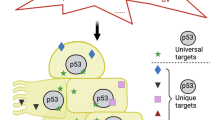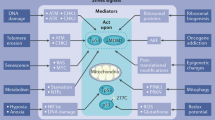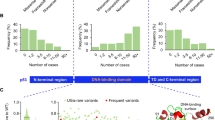Abstract
To investigate the functions of the p53 tumor suppressor, we created a new knock-in gene replacement mouse model in which the endogenous Trp53 gene is substituted by one encoding p53ERTAM, a p53 fusion protein whose function is completely dependent on ectopic provision of 4-hydroxytamoxifen. We show here that both tissues in vivo and cells in vitro derived from such mice can be rapidly toggled between wild-type and p53 knockout states. Using this rapid perturbation model, we define the kinetics, dependence, persistence and reversibility of p53-mediated responses to DNA damage in tissues in vivo and to activation of the Ras oncoprotein and stress in vitro. This is the first example to our knowledge of a new class of genetic model that allows the specific, rapid and reversible perturbation of the function of a single endogenous gene in vivo.
This is a preview of subscription content, access via your institution
Access options
Subscribe to this journal
Receive 12 print issues and online access
$209.00 per year
only $17.42 per issue
Buy this article
- Purchase on SpringerLink
- Instant access to full article PDF
Prices may be subject to local taxes which are calculated during checkout








Similar content being viewed by others
References
Sherr, C.J. Principles of tumor suppression. Cell 116, 235–246 (2004).
Donehower, L.A. et al. Mice deficient for p53 are developmentally normal but susceptible to spontaneous tumours. Nature 356, 215–221 (1992).
Vater, C., Bartle, L., Dionne, C., Littlewood, T. & Goldmacher, V. Induction of apoptosis by tamoxifen-activation of a p53-estrogen receptor fusion protein expressed in E1A and T24 H-ras transformed p53-/- mouse embryo fibroblasts. Oncogene 13, 739–748 (1996).
Harvey, M., McArthur, M.J., Montgomery, C.A. Jr., Bradley, A. & Donehower, L.A. Genetic background alters the spectrum of tumors that develop in p53-deficient mice. Faseb J. 7, 938–943 (1993).
Harvey, M. et al. Spontaneous and carcinogen-induced tumorigenesis in p53-deficient mice. Nat. Genet. 5, 225–229 (1993).
Cui, Y.F. et al. Apoptosis in bone marrow cells of mice with different p53 genotypes after γ-rays irradiation in vitro . J. Environ. Pathol. Toxicol. Oncol. 14, 159–163 (1995).
Botchkarev, V.A. et al. p53 is essential for chemotherapy-induced hair loss. Cancer Res. 60, 5002–5006 (2000).
Fei, P., Bernhard, E.J. & El-Deiry, W.S. Tissue-specific induction of p53 targets in vivo . Cancer Res. 62, 7316–7327 (2002).
Kemp, C.J., Sun, S. & Gurley, K.E. p53 induction and apoptosis in response to radio- and chemotherapy in vivo is tumor-type-dependent. Cancer Res. 61, 327–332 (2001).
Komarova, E.A., Christov, K., Faerman, A.I. & Gudkov, A.V. Different impact of p53 and p21 on the radiation response of mouse tissues. Oncogene 19, 3791–3798 (2000).
Potten, C.S., Merritt, A., Hickman, J., Hall, P. & Faranda, A. Characterization of radiation-induced apoptosis in the small intestine and its biological implications. Int. J. Radiat. Biol. 65, 71–78 (1994).
Song, S. & Lambert, P.F. Different responses of epidermal and hair follicular cells to radiation correlate with distinct patterns of p53 and p21 induction. Am. J. Pathol. 155, 1121–1127 (1999).
Lowe, S.W., Schmitt, E.M., Smith, S.W., Osborne, B.A. & Jacks, T. p53 is required for radiation-induced apoptosis in mouse thymocytes. Nature 362, 847–849 (1993).
Attardi, L.D., de Vries, A. & Jacks, T. Activation of the p53-dependent G1 checkpoint response in mouse embryo fibroblasts depends on the specific DNA damage inducer. Oncogene 23, 973–980 (2004).
Fei, P. & El-Deiry, W.S. p53 and radiation responses. Oncogene 22, 5774–5783 (2003).
Midgley, C.A. et al. Coupling between γ irradiation, p53 induction and the apoptotic response depends upon cell type in vivo . J. Cell Sci. 108 (Pt 5), 1843–1848 (1995).
Ferbeyre, G. et al. Oncogenic ras and p53 cooperate to induce cellular senescence. Mol. Cell. Biol. 22, 3497–3508 (2002).
Palmero, I., Pantoja, C. & Serrano, M. p19ARF links the tumour suppressor p53 to Ras. Nature 395, 125–126 (1998).
Sherr, C.J. & DePinho, R.A. Cellular senescence: mitotic clock or culture shock? Cell 102, 407–410 (2000).
Harvey, M. et al. In vitro growth characteristics of embryo fibroblasts isolated from p53-deficient mice. Oncogene 8, 2457–2467 (1993).
Fukasawa, K., Wiener, F., Vande Woude, G.F. & Mai, S. Genomic instability and apoptosis are frequent in p53 deficient young mice. Oncogene 15, 1295–1302 (1997).
Hanawalt, P.C., Ford, J.M. & Lloyd, D.R. Functional characterization of global genomic DNA repair and its implications for cancer. Mutat. Res. 544, 107–114 (2003).
Adimoolam, S. & Ford, J.M. p53 and regulation of DNA damage recognition during nucleotide excision repair. DNA Repair (Amst) 2, 947–954 (2003).
Hayflick, L. Living forever and dying in the attempt. Exp. Gerontol. 38, 1231–1241 (2003).
Tarapore, P. & Fukasawa, K. Loss of p53 and centrosome hyperamplification. Oncogene 21, 6234–6240 (2002).
Bienz, B., Zakut-Houri, R., Givol, D. & Oren, M. Analysis of the gene coding for the murine cellular tumour antigen p53. EMBO J. 3, 2179–2183 (1984).
Littlewood, T.D., Hancock, D.C., Danielian, P.S., Parker, M.G. & Evan, G.I. A modified oestrogen receptor ligand-binding domain as an improved switch for the regulation of heterologous proteins. Nucleic Acids Res. 23, 1686–1690 (1995).
White, I.N. Tamoxifen: is it safe? Comparison of activation and detoxication mechanisms in rodents and in humans. Curr. Drug Metab. 4, 223–239 (2003).
Ginzinger, D.G. Gene quantification using real-time quantitative PCR: an emerging technology hits the mainstream. Exp. Hematol. 30, 503–512 (2002).
Livak, K.J. & Schmittgen, T.D. Analysis of relative gene expression data using real-time quantitative PCR and the 2(-Delta Delta C(T)) Method. Methods 25, 402–408 (2001).
Dimri, G.P. et al. A biomarker that identifies senescent human cells in culture and in aging skin in vivo . Proc. Natl. Acad. Sci. USA 92, 9363–9367 (1995).
Acknowledgements
We thank L. Heath for help with interpretation of the pathology of the Trp53KI/KI tumors; P. Rodriquez-Viciana for the H-ras V-12 retroviral vector; T. Littlewood for the p53minER vector; I. Rosewell for electroporation of ES cells; F. Rostker for assistance with animals; D. Ginzinger for Taqman analyses; A. Finch for assistance with histology and imaging; and F. McCormick, K. Shannon, D. Green, T. Tlsty, K. Vousden, R. Treisman, C. O'Shea, D. Iacovides and the members of the laboratory of G.I.E. for discussions, advice and criticism. This work was supported by grants from the US National Institutes of Health and by the University of California San Francisco Comprehensive Cancer Center Cell Cycle and Signaling Disregulation Program. D.M.-Z. was supported by grants from the Spanish Ministry of Science and Education. We dedicate our work to the memory of Stanley Korsmeyer.
Author information
Authors and Affiliations
Corresponding author
Ethics declarations
Competing interests
The authors declare no competing financial interests.
Rights and permissions
About this article
Cite this article
Christophorou, M., Martin-Zanca, D., Soucek, L. et al. Temporal dissection of p53 function in vitro and in vivo. Nat Genet 37, 718–726 (2005). https://doi.org/10.1038/ng1572
Received:
Accepted:
Published:
Issue Date:
DOI: https://doi.org/10.1038/ng1572
This article is cited by
-
Translating p53-based therapies for cancer into the clinic
Nature Reviews Cancer (2024)
-
Characterizing the role of Phlda3 in the development of acute toxicity and malignant transformation of hematopoietic cells induced by total-body irradiation in mice
Scientific Reports (2023)
-
Anticancer efficacy of hirsuteine against colorectal cancer by opposite modulation of wild-type and mutant p53
Discover Oncology (2023)
-
Interplay between HMGA and TP53 in cell cycle control along tumor progression
Cellular and Molecular Life Sciences (2021)
-
Emerging mechanisms of cell competition
Nature Reviews Genetics (2020)



